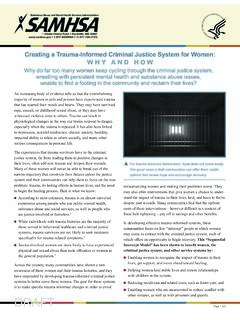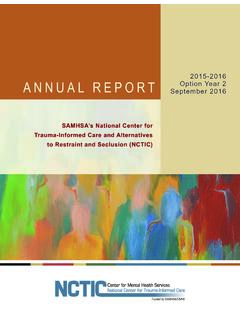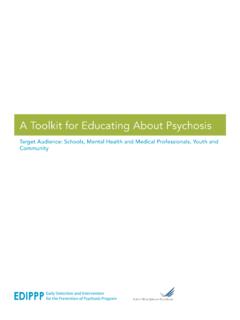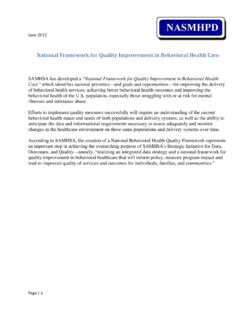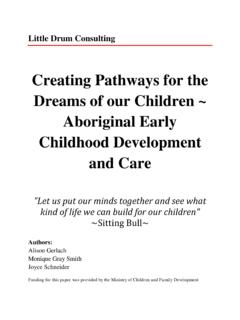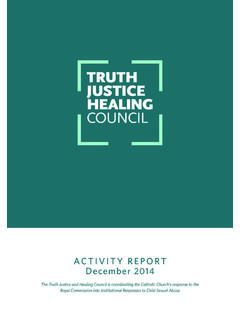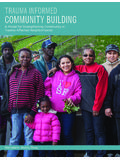Transcription of SAMHSA’s Trauma-Informed Approach: Key Assumptions ...
1 SAMHSA s Trauma-Informed Approach: Key Assumptions & PrinciplesTA DRAFT Document Substance Abuse and Mental Health Services Department of Health and Human ServicesThe views, opinions, and content expressed in this presentation do not necessarily reflect the views, opinions, or policies of the Center for Mental Health Services (CMHS) or the Center for Substance Abuse Treatment (CSAT), the Substance Abuse and Mental Health Services Administration (SAMHSA), or the Department of Health and Human Services (HHS).2 Disclaimer3 Understanding trauma ?SECTION: 1 Learning ObjectivesShared understandingIdentification of traumaAwareness of prevalenceSlide 4 Things to RememberUnderlying question = What happened to you? Symptoms = Adaptationsto traumatic eventsHealing happensIn relationshipsVideo: Power of EmpathySlide 5 What is trauma ?
2 Slide 6 Individual trauma results from an event, series of events, or set of circumstances that is experiencedby an individual as physically or emotionally harmful or life threatening and that has lasting adverse effectson the individual s functioning and mental, physical, social, emotional, or spiritual cause individual s experienceof the event determines whether it is of trauma include adverse physical, social, emotional, or spiritual Three Es in TraumaSlide 7 Potential Traumatic EventsAbuseEmotionalSexualPhysicalDomest ic violenceWitnessing violenceBullyingCyberbullyingInstitution alLossDeathAbandonmentNeglectSeparationN atural disasterAccidentsTerrorismWarChronic StressorsPovertyRacismInvasive medical procedureCommunity traumaHistorical traumaFamily member with substance use disorderSlide 8 Experience of TraumaExperience of trauma affected by:HowWhenWhereHow OftenSlide 9 Discussion QuestionHow can the same event be traumatic for one person and not for another?
3 Slide 10 Effect of TraumaThe effect of trauma on an individual can be conceptualized as a normal response to an abnormal 11 Effect (con.)Slide 12 trauma can: Cause short and long-term effects. Affect coping responses, relationships, or developmental tasks. Impact physiological responses, well-being, social relationships, and/or spiritual of trauma ResponsesBehavioralBlowing up when being corrected Fighting when criticized or teasedResisting transitions or changeVery protective of personal spaceReckless or self-destructive behaviorFrequently seeking attentionReverting to younger behaviorsEmotional/PhysicalNightmares or sleeping problemsSensitive to noise or to being touchedFear of being separated from familyDifficulty trusting othersFeeling very sad, angry, afraid.
4 Emotional swingsUnexplained medical problemsPsychologicalConfusing what is safe and what is dangerousTrouble focusing or concentratingDifficulty imagining the futureSlide 13 Additional Signs of TraumaSlide 14 Flashbacks or frequent nightmares Sensitivity to noise or to being touched Always expecting something bad to happen Not remembering periods of your life Feeling emotionally numb Lack of concentration; irritability Excessive watchfulness, anxiety, anger, shame, or sadnessHow trauma Affects the Brain Experiences Build Brain Architecture Serve & Return Interaction Shapes Brain Circuitry Toxic Stress Derails Healthy DevelopmentSlide 15 Brain DevelopmentSlide 16 MotherCaregiverFamily and FriendsPeers, TeachersCommunity17 Brainstem Blood pressure Body temperature Heart rate Arousal states Diencephalon Motor regulation Affect regulation Hunger/satiety Sleep Limbic Affiliation Attachment Sexual Behavior Emotional Reactivity Neocortex Abstract Thought Concrete ThoughtBottom Up Reactions to FearSlide 18 Problems OR Adaptations?
5 Slide 19 FIGHT Non-compliant, combative OR Struggling to regain or hold onto personal power FLIGHT Treatment resistant, uncooperative OR Disengaging, withdrawing FREEZE Passive, unmotivated OR Giving in to those in power Factors Increasing ImpactEarly occurrenceBlaming or shamingBeing silenced or not believedPerpetrator is trusted caregiverSlide 20 Adverse Childhood Experiences (ACEs) Affect Adult Health Adoption of health risk behaviors as coping mechanisms ( , eating disorders, smoking, substance abuse, self-harm, sexual promiscuity) Severe medical conditions ( , heart disease, pulmonary disease, liver disease, STDs, gynecologic cancer) Early deathACEs have serious health consequences for adults: (Felitti et al, 1998)Slide 21 The ACE Study Male child with an ACE score of 6 has a 4600% increase in likelihood of later becoming an IV drug user when compared to a male child with an ACE score of 0.
6 Might heroin be used for the relief of profound anguish dating back to childhood experiences? Might it be the best coping device that an individual can find? (Felitti et al, 1998)Slide 22 trauma Prevalence in Children71% Number of children who are exposed to violence each year (Finklehor, et al, 2013) 3 million Number of children maltreated or neglected each year (Child Welfare , 2013) million Children witness violence against their mother each year (Child Witness to Violence Project, 2013)1 in 4 girls & 1 in 6 boys Number who are sexually abused before adulthood (NCTSN Fact Sheet, 2009)94%Percentage of children in a study of juvenile justice settings who have experienced trauma (Rosenberg, et al, 2014)Slide 23 Prevalence (Children) (con.)40-80%of school-age children experience bullying (Graham, 2013) 75-93% of youth entering the juvenile justice system have experienced trauma (Justice Policy Institute, 2010)92% of youth in residential and 77% in non-residential mental health treatment report multiple traumatic events(NCTSN, 2011)Slide 24 trauma in Adults: Mental Health84%+Adult mental health clients with histories of trauma (Meuser et al, 2004) 50% of female & 25% of male clientsExperienced sexual assault in adulthood(Read et al, 2008)Slide 25 trauma in Adults: Mental Health (con.)
7 Clients with histories of childhood abuse Earlier first admissions More frequent and longer hospital stays More time in seclusion or restraint Greater likelihood of self-injury or suicide attempt More medication use More severe symptoms (Read et al, 2005)Slide 26 trauma in Adults: Substance AbuseUp to 65% of all clients in substance abuse treatment report childhood abuse (SAMHSA, 2013)Up to 75% of women in substance abuse treatment report trauma histories (SAMHSA, 2009)Slide 27 trauma in Adults: Substance Abuse (con.)Over 92% of homeless mothers have severe trauma histories. They have twice the rate of drug and alcohol dependence as those without(SAMHSA 2011)Almost 1/3 of all veterans seeking treatment for a substance use disorder have PTSD (National Center for PTSD)Slide 28 DiscussionQuestionWhat makes something traumatic?
8 Slide 29 Section 2: Principles of Trauma-Informed Approaches30 LearningObjectivesExplain why Trauma-Informed programs operate with the universal expectation that trauma has occurredExplain each of SAMHSA s principles and why it is importantGive positive examples of the implementation of each principleName at least 3 changes that would make your own work setting more trauma -informedSlide 31 Slide 32St. Aemilian-Lakeside Video about a Trauma-Informed program for children with emotional and behavioral problemsSt. Aemilian-Lakeside Trauma-Informed CareSlide 33 The Four Rs Realizeswidespread impact of trauma and understands potential paths for recoveryRealizes Recognizessigns and symptoms of trauma in clients, families, staff, and others involved with the system Recognizes Respondsby fully integrating knowledge about trauma into policies, procedures, and practicesResponds Seeks to actively Trauma-Informed program, organization, or system: Slide 34 SAMHSA s PrinciplesSlide 35 Six principles that guide a Trauma-Informed change process Developed by national experts, including trauma survivors Goal.
9 Establish common language/framework Values-based A way of beingSAMHSA s Six Key Principles of a Trauma-Informed ApproachSlide 36 Safety Trustworthiness and Transparency Peer Support Collaboration and Mutuality Empowerment, Voice, and Choice Cultural, Historical, and Gender IssuesPrinciple 1: SafetyThroughout the organization, staff and the people they serve, whether children or adults, feel physically and psychologically : Leah HarrisSlide 37 Who Defines Safety?Slide 38 For people who use services: Safety generally means maximizing control over their own livesFor providers: Safety generally means maximizing control over the service environment and minimizing riskDiscussionDo staff feel safe in your organization? Why or why not?Do the people served feel safe?
10 How do you know? What changes could be made to address safety concerns?Slide 39 Principle 2: Trustworthiness and TransparencyOrganizational operations and decisions are conducted with transparency and the goal of building and maintaining trust among clients, family members, staff, and others involved with the : Pat RisserSlide 40 Examples of Trustworthiness Making sure people really understand their options Being authentic Directly addressing limits to confidentialitySlide 41 DiscussionSlide 42 How can we promote trust throughout the organization? Do the people served trust staff? How do you know? What changes could be made to address trust concerns?Principle 3: Peer SupportPeer support and mutual self-help are key vehicles for establishing safety and hope, building trust, enhancing collaboration, serving as models of recovery and healing, and maximizing a sense of : Cicely SpencerSlide 43 Examples of Peer SupportPeer support = A flexible approach to building mutual, healing relationships among equals, based on core values and principles:VoluntaryNon-judgmentalRespec tfulReciprocalEmpatheticSlide 44 DiscussionDoes your organization offer access to peer support for the people who use your services?

